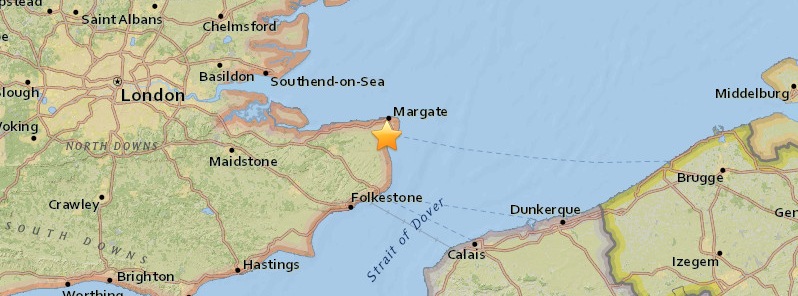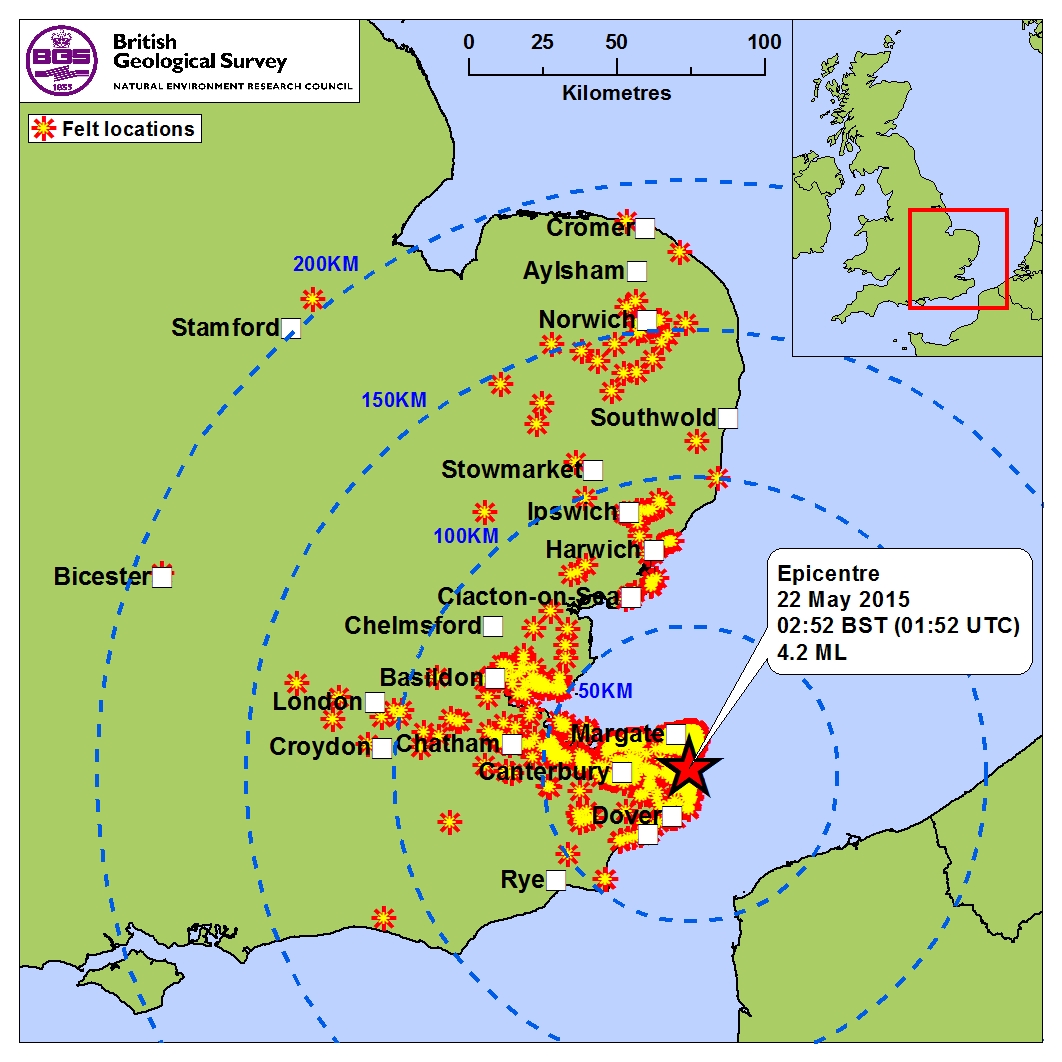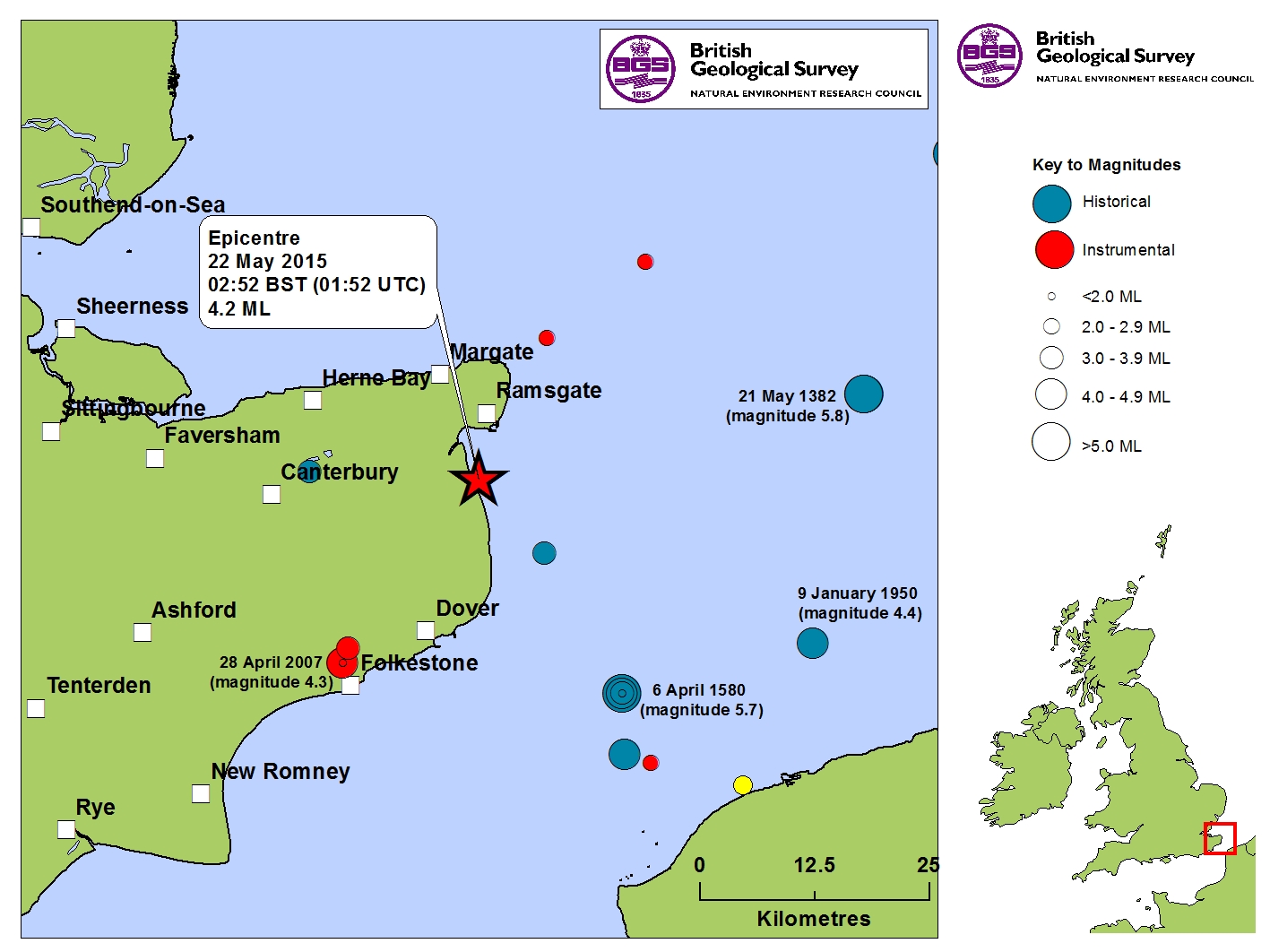M4.2 earthquake registered near London, UK

Magnitude 4.2 earthquake was registered by BGS at a depth of 15 km (9.3 miles) approximately 7 km (4.3 miles) S of Ramsgate, Kent, UK at 01:52 UTC on May 22, 2015. USGS registered it as M3.7 at a depth of 10 km (6.2 miles).
This location is approximately 24 km northeast of the damaging M4.3 Folkestone earthquake (the strongest since 1955 M4.4) that occurred on April 28, 2007, and about 106 km (66 miles) east of capital London.
Earthquakes of magnitude 4.2 ML occur in mainland UK roughly every 5 years although are more common in offshore areas, BGS said.
BGS received over 930 felt reports from an automatic online questionnaire survey from members of the public, almost all of them coming from within a 75 km radius of the epicenter, covering Ramsgate and Margate and their surrounding hamlets, as far south as Dover and Folkestone (approximately 18 – 26 km southwest of the epicenter), Canterbury (approximately 22 km to the west of the epicenter) and Herne Bay (approximately 20 km to the northwest of the epicenter). Further afield, reports have been received from the Faversham, Chatham, Basildon and Southend-on-Sea areas.

Preliminary map showing location from where felt reports have been received for the magnitude 4.2 Ramsgate earthquake of May 22, 2015. Image credit: BGS.
The most distant reports have been received from Norwich, North Walsham and Cromer.
Houses shake as earthquake hits east Kent this morning….really! http://t.co/nL5Hsv7kei pic.twitter.com/2puSPhWSrW
— Kentish Gazette (@KentishGazette) May 22, 2015
Almost all of the reports indicated that people were awoken from their sleep. Over half the reports described the shaking strength of the earthquake to be moderate, mainly with a trembling effect, and described the sound strength as moderate. Over two thirds of the reports stated that windows rattled and one third reported furniture shaking, BGS said.
2007 M4.3 Folkstone earthquake
At 07:18 UTC on April 28, 2007, BGS recorded a magnitude of 4.3 ML earthquake with the epicenter approximately 14 km South of Dover in the Dover Straits. Reports suggest that the earthquake has been felt widely across southeast England, causing minor damage to masonry and roofing. Loss of power has also been reported.
It was the largest earthquake in this region since a magnitude 4.4 ML earthquake in 1950.

Seismicity map showing all historical and instrumental earthquakes within a 50 km radius of the magnitude 4.2 Ramsgate earthquake of May 22, 2015. Image credit: BGS.
Significant earthquakes also struck the Dover Straits in 1776 and 1580; the latter had an approximate magnitude of 5.7 ML and reportedly caused damage in London. Earthquakes of that size occur in mainland UK roughly every 7 – 8 years although are more common in offshore areas.
A magnitude 4.7 ML earthquake struck Dudley, West Midlands in 2002 and was widely felt across England and Wales.
Detailed analysis all available seismic data from 2007 M4.3 Folkstone earthquake done by the BGS shows that the epicenter was less than 1 km east of Folkestone and close to the area of maximum reported damage. The event occurred at shallow depth, probably less than 5 km below the surface.
"The maximum intensity is currently assessed as 8 EMS (European Macro seismic Scale); it is possible this may be downgraded to 7 EMS when the data have been fully analyzed. This is the highest recorded intensity for a British earthquake in over 100 years," BGS explains.
The worst damage was concentrated within one area of Folkestone. In the most affected group of streets, serious structural damage to a few houses was observed, including large cracks in load-bearing walls.
There have been many cases of damage to chimneys, with fall of chimney pots and fall of brickwork from the upper part of the chimney stacks, with secondary damage to roofs from falling masonry.
Featured image credit: USGS

Commenting rules and guidelines
We value the thoughts and opinions of our readers and welcome healthy discussions on our website. In order to maintain a respectful and positive community, we ask that all commenters follow these rules:
We reserve the right to remove any comments that violate these rules. By commenting on our website, you agree to abide by these guidelines. Thank you for helping to create a positive and welcoming environment for all.